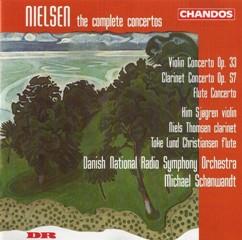Carl Nielsen – Complete Concertos (1990)
Carl Nielsen – Complete Concertos (1990)

Violin Concerto, Op. 33
I. Praeludium: Largo - Allegro cavalleresco 18:54
II. Poco adagio 6:26 play
III. Rondo: Allegretto scherzando 10:36
Clarinet Concerto, Op. 57 24:41
Flute Concerto
I. Allegro moderato 11:06
II. Allegretto 7:14
Kim Sjogren (Violin) Toke Lund Christiansen (Flute) Niels Thomsen (Clarinet) Danish National Radio Symphony Orchestra Michael Schoenwandt – conductor
Although Finland's extraordinary Jean Sibelius may be foremost among Nordic composers, his contemporary, Carl Nielsen -- best known for six highly original symphonies and simple popular songs -- holds an honored place as Denmark's foremost post-Romantic musical ambassador, and has found considerable acclaim amongst musicians and audiences alike.
A painter by profession, Nielsen's father spent as much or more energy on his secondary activities as a violinist, and it was in this way that young Carl received his first musical instruction. At 14 Carl auditioned for a position with a military wind ensemble at Odense (he was hired as a bugler, despite his lack of formal training on the instrument). During a visit to Copenhagen in 1883, Nielsen was introduced to composer Niels W. Gade, who suggested that the young musician enroll at the Conservatory for serious studies. During Nielsen's three years at the Conservatory (1884-1886) his primary subjects were violin and theory, and at no time did he actually receive formal instruction in composition. Nevertheless, in 1888 his Suite for Strings, Op.1 received a successful debut in Copenhagen.
In 1889 Nielsen was hired as a violinist at the Royal Theatre in Copenhagen, a position he retained until 1905 (though in 1891 he journeyed to Paris, where he met and married Danish sculptress Anne Marie Brodersen). During the 1890s Nielsen composed prolifically, and much of his output was put into print. By 1903 he had signed a contract with the Wilhelm Hansen publishing firm in Copenhagen, effectively ending his tenure with the Royal Theatre (though he would not officially resign for two more years). His career as a conductor began in 1908 when he accepted a staff position with the Royal Theatre Orchestra. From 1916 until his death in 1931 (of heart disease), he taught at the Royal Danish Conservatory.
Nielsen's music is highly individual in both content and construction, although only the symphonies and the three concertos (violin, flute, and clarinet) have earned places in the repertory outside Denmark (where many of his choral pieces have become part of the national heritage). Each of the three concertos is a worthy contribution to its instrument's literature, though perhaps the Clarinet Concerto deserves the most attention. While starting out from the perspective of Classical form and harmony, his music later developed into an "extended" tonal and even atonal language, born of his highly expressive melodic style.
Like his colleague Sibelius, Nielsen poured his finest material into the symphonic mold. From the early First Symphony of 1892 (which is one of the first such works to begin and end in different keys), to the famous Fourth Symphony ("The Inextinguishable," a reference to the enduring power of both life and music), each is a noble testament to a remarkable man's view of the world around him. --- arkivmusic.com
download: uploaded yandex 4shared mediafire solidfiles mega filecloudio nornar ziddu
Last Updated (Sunday, 02 March 2014 22:11)








